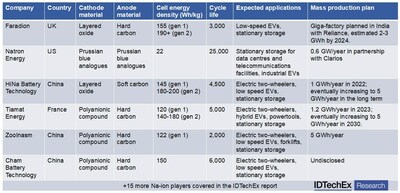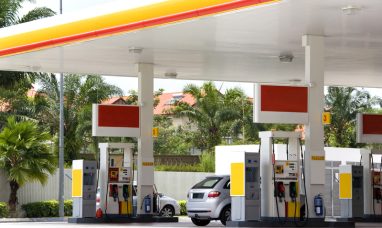BOSTON, July 14, 2023 /PRNewswire/ —
Diversification in the Energy Storage Industry Is Foreseeable
As the world progresses rapidly towards electrification, the energy storage industry is increasingly reliant on critical raw materials such as lithium and cobalt. Diversification of battery chemistries is critical for long-term capacity growth. It should be self-evident that no single battery chemistry possesses all the attributes for every single application – each market has its nuances and requires unique solutions. The sodium-ion (Na-ion) chemistry will certainly not be the answer for all applications; however, it will be well-suited to complement, rather than displace, the existing and future lithium-ion technologies in many applications. Concerns of energy security and geopolitical considerations in the supply chain also drive nations without local access to lithium-ion raw materials to seek alternative chemistries to meet energy storage demands.

Small Pilot Plants and Big Plans
Currently, mainly pilot plants are running, and a few smaller factories are starting up, which only produce a few gigawatt hours (GWh) of Na-ion batteries per year, but the capacities that have been publicly announced by various raw material manufacturers alone add up to well over 100 GWh over the next three years. However, once the production processes are known, it takes less than two years to build up further capacities. By 2025, significantly more capacity can be built up than has been financed so far if investors are found for it in the course of 2023. The forecast of a radical conversion of a large part of the industry to a new technology in a few years may sound bold, but in the last five years alone, this has happened twice in the battery industry with NMC811 and LFP. Na-ion requires hardly any new plant technology, just different starting materials and production parameters. The latest report from IDTechEx, “Sodium-ion Batteries 2023-2033: Technology, Players, Markets, and Forecasts“, covers the global commercialization efforts of Na-ion batteries by analyzing patents and finds that China is taking the lead once again.
Outlook: Demand Not Limited by Lack of Raw Materials
IDTechEx forecast that by 2025, around 10 GWh of Na-ion batteries will be installed as significant manufacturing capacities come online and existing Li-ion lines are converted to Na-ion production. Success (or failure) for one player can significantly impact the market. A CAGR of 27% is expected for the period 2025-2033. Growth follows a similar market growth rate as that of Li-ion batteries. Over the next 10 years, the addressable markets will likely be far higher than the expansion of Na-ion supply chains and manufacturing capacities or even demand. But there may be potential for more rapid growth than forecast once the technology is trusted, qualified, bankable, available, etc. Importantly, Na-ion is a drop-in technology to Li-ion’s current production lines. Gigafactories can be retrofitted to produce Na-ion cells relatively quickly. The production capacities of the material manufacturers also indicate that significantly more companies will build their own sodium batteries in 2024 and that there could be much larger capacities in 2025.
Significant Savings Over LFP Are Unlikely Initially
There is currently no cost-effective battery technology with an energy density between lead and lithium batteries. According to IDTechEx research, the average cell cost for Na-ion batteries is US$87/kWh taking different chemistries into account. By the end of the decade, the production cost of Na-ion battery cells using primarily iron and manganese will probably bottom out at around US$40/kWh, which would be around US$50/kWh at the pack level. Na-ion cells are likely to come at a price premium initially, but IDTechEx expect a drop in cost/price in the short term through manufacturing efficiencies, scale, and technology development. However, long-term cost reductions become harder as technology and manufacturing become more established and mature. The IDTechEx report includes modeling of various Na-ion chemistries with a breakdown of the material and prices.
Sodium Is Not the End for Lithium
For most EVs, volumetric energy density is the first or second priority because the more space a battery cell takes up for a given energy density, the fewer cells you can squeeze under a vehicle, limiting range. For grid storage, the space that the battery packs take up doesn’t affect their commercial viability, and the priority is the cost per kWh per cycle. Commercial energy storage is all about cost control, and this is where sodium ions can potentially dominate other chemistries. The greatest potential in transport applications for Na-ion batteries exists wherever the energy density of lithium batteries is not fully utilized. This includes almost all electric cars with a so-called standard range, i.e., reduced battery capacity compared to more expensive models of the same construction. There, sodium batteries with higher charging speeds and less capacity loss in cold temperatures could represent a very attractive alternative. Above all, thanks to this alternative energy storage technology, lithium batteries will be available where they are truly indispensable.
To find out more about the IDTechex report “Sodium-ion Batteries 2023-2033: Technology, Players, Markets, and Forecasts“, including downloadable sample pages, please visit www.IDTechEx.com/Sodium.
About IDTechEx
IDTechEx guides your strategic business decisions through its Research, Subscription and Consultancy products, helping you profit from emerging technologies. For more information, contact [email protected] or visit www.IDTechEx.com.
Images download:
https://www.dropbox.com/scl/fo/atyso88n1ugli8pg6aq29/h?dl=0&rlkey=zry1hnjrsiu5iir0mu8sgktoo
Media Contact:
Lucy Rogers
Sales and Marketing Administrator
[email protected]
+44(0)1223 812300
Social Media Links:
Twitter: www.twitter.com/IDTechEx
LinkedIn: www.linkedin.com/company/IDTechEx
Photo – https://mma.prnewswire.com/media/2153602/Cell_Specifications.jpg
Logo – https://mma.prnewswire.com/media/478371/IDTechEx_Logo.jpg

![]() View original content:https://www.prnewswire.co.uk/news-releases/cheaper-and-safer-sodium-ion-batteries-on-the-horizon-reports-idtechex-301876787.html
View original content:https://www.prnewswire.co.uk/news-releases/cheaper-and-safer-sodium-ion-batteries-on-the-horizon-reports-idtechex-301876787.html

Featured image: Megapixl © think4photop















